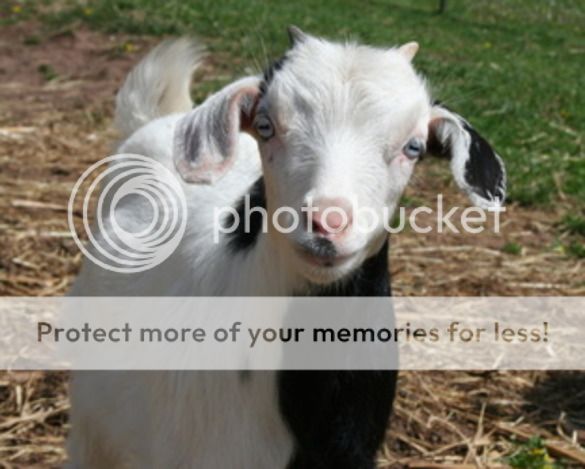-
*Astrella.
User deleted
The fainting goats: a particular strange gene

The lives of goats, by all appearances, consist mostly of eating, climbing, butting heads and a whole lot of standing on top of things. One particular breed of goat, however, is known for a rather different trait: stiffening up and appearing to faint.
Footage of these fainting goats continues to make the rounds on video-sharing Web sites and cable animal programs. After all, what's more hilarious than watching an entire pack of goats keel over in unison every time a farmer runs up to them with an umbrella?
Fainting Goats
by National Geographic
funny fainting goats...!!!
by raj kumar
Yet despite all appearances, these goats (also known as myotonic goats, "Tennessee stiff-legs," "Tennessee wooden-legs," "nervous goats" and "fall-down goats") aren't simply weak of heart or abnormally prone to fright. In fact, fainting goats don't actually faint or lose consciousness at all during these episodes. Due to an congenital (present from birth) medical condition known as myotonia congenita or Thomsen's disease, the goat's muscles tense up when the animal is startled and don't immediately relax. Think of it as a full-body charley horse, except without the pain.
The severity of the condition varies. Some fainting goats will stiffen up every time they're startled, others less frequently. Symptoms often lessen over time and some animals are able to better adapt to the condition. Younger goats are more prone to fall over and tumble when startled, but as they grow older, many eventually manage to avoid falling down altogether during an episode.
They simply run away from a threat on stiffened legs. Older goats also tend to become more secure with their environment and startle less easily.
In this article, we'll take a closer look at this rare breed of goat. We'll look at how myotonic congenita works and how it affects the goats' lives. We'll also examine how they came to be considered a breed and why anyone would choose to encourage their fainting spells.


Why Fainting Goats Faint
To understand what happens when a myotonic goat is frightened and faints, it's helpful to first take a look at what happens under normal conditions. If a person were to chase after a goat unaffected by myotonia congenita, the animal's eyes and ears would relay the perceived threat to the brain, which would then send an electrical signal to the skeletal muscles (such as those in the leg and neck involving voluntary movement), causing a momentary tensing. This is often referred to as the fight or flight response.
Just think how it feels to be startled, or have a friend remind you. You'll find your voluntary muscles contract and tighten for a second. This is your brain telling your muscles that the time has come to possibly confront or run away from an immediate threat.
Normally, this tensing is followed by an immediate relaxing of the affected muscles, allowing a typical goat to actually turn and run away from a perceived threat. With myotonia congenita, however, the muscles tense and stay tensed before slowly relaxing.
Think about that moment of muscle tension following a sudden fright -- now imagine it lasting 10 to 20 seconds.
Due to abnormalities at the cellular level, the voluntary muscles of myotonic animals receive the electric signal from the brain to tense and keep tensing instead of releasing -- sort of like a skipping record.
This happens because myotonia congenita affects a particular gene called CLCN1 (Choloride Channel 1). This gene is involved in the production and regulation of proteins, which are vital to the flexing and relaxing of skeletal muscles. Positively charged sodium ions relay the brain's message for the muscle cells to contract. Negatively charged chloride ions, which CLCN1 affects, tell the muscle cells to relax. Mytonia congenita results in an abnormal channel of chloride ions, which throws this relationship out of balance. The muscle cells wind up with more than enough sodium but not enough chloride, which causes abnormal repetitive electrical signals from the brain (such as those associated with being startled) to result in stiffness.
While the fainting goats often receive the most press, myotonia congenita can be found in various other animals as well, all the way up from mice to human beings.
The condition is hereditary, and can be either a dominant trait (the gene only has to be inherited from one parent) or recessive trait (the gene is carried by both parents). Where fainting goats differ from other myotonic animals, however, is that they're actually bred to encourage myotonia congenita in their offspring.
Some humans with the disorder take medication or undergo physical therapy in order to manage their condition, and a number of miniature schnauzer breeders use genetic screening to avoid producing myotonic puppies, but the fainting goat is bred, raised and encouraged to seize up and tumble.
In the next section, we'll look at why a goat breeder would consider myotonia congenita a desired trait.ETHICAL CONCERNS
As fainting goats are selectively bred to encourage myotonia congenita, ethical concerns are occasionally raised about the practice, and breeders are quick to assure others that nothing cruel is taking place as the goats don't experience pain during the fainting episodes.
However, according to Kathy Guillermo, director of research for People for the Ethical Treatment of Animals (PETA), the raising of fainting goats offers few benefits in the eyes of her organization.
The Humane Society, on the other hand, doesn't come down nearly as hard on the breed.
Any concerns raised by their selective breeding, according to Humane Society representative Jordan Crump, are light compared to various breeding issues in the meat and chicken industries and are more or less on par with some of health problems common to specific breeds of dogs. He also added that, given the novelty of fainting goats, most of the animals likely experience better care than common farm goats.
Currently, neither the Humane Society of the United States or PETA has an official stance on the specific issue.

Source: http://science.howstuffworks.com/zoology/fainting-goat.htm.
The fainting goats: a particular strange gene21 Dicembre 2013 |


